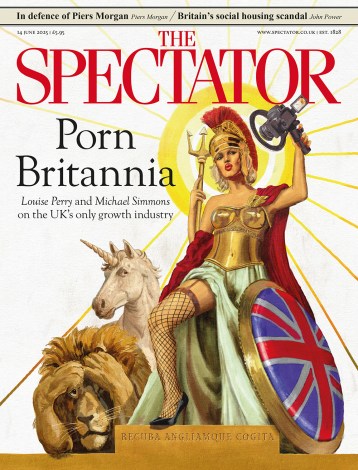
A combination of art history ‘lite’ and the personal touch — a common yoking together these days, even in books supposedly of art history ‘full strength’ — makes for, in Philip Hook’s hands, an engaging read. As a dealer and auctioneer, and the author of several thrillers, he has advantages not given to the general run of such investigative writers. His subject is the rise of French Impressionist painting, after its initial years of critical contempt and commercial failure, to international mass appeal and soaring value. It’s a familiar story, frequently told, and a reader looking for new light on the fortunes of Monet, Pissarro, Renoir, Sisley et al. will search in vain. Where Hook scores is in his practical experience. He brings a shrewd and sometimes comic touch to his portraits of dealers and collectors; he has some good quotations (from Henry James to Michael Innes); he knows the peculiar psychology of collecting and the smooth duplicity of dealing. If he is wary of offending his readers with any show of Burlington-esque scholarship, he is reliable on the broad outline.
In 1899, the 59-year-old Alfred Sisley lay dying of throat cancer in his modest rented home in Moret-sur-Loing. His last letters to his doctor in Paris are pathetic documents; poverty accompanied him to the end. He had the good sense, however, to call to his deathbed his old friend Monet to ask him to help his two children. Monet threw his energies into the organisation of a benefit auction in Paris, mostly of Impressionist works donated by Sisley’s colleagues. It was a great success, with vulterine dealers paying over the estimates. A year later one of Sisley’s most beautiful and famous works ‘Flood at Port-Marly’ was sold in the saleroom to Count Isaac de Camondo for 43,000 francs, by far the highest price yet achieved by a Sisley.
While Hook does not recount this episode, it is highly representative of the thrust of his first chapters. Sisley and Pissarro were the least fortunate of the original Impressionists; but Monet and Renoir lived long enough to see the tide turn and by the time of his death in 1926, Monet was rich and internationally known, with American and Japanese admirers by the dozen motoring from Paris out to Giverny.
Hook’s narrative then fans out from France — notably backward in the public acquisition of Impressionist paintings — to collectors, museums and dealers in Germany and Switzerland (both countries generally keen), Britain (sluggish and snooty) and, of course, America (hooveringly greedy). It is here that a slight problem arises in Hook’s analysis. There is a world of difference between an archetypal Impressionist view or interior (as sold by the leading Impressionist dealer Durand-Ruel) and those of the Post-Impressionists, principally Gauguin, Van Gogh, Seurat and Cézanne. Although perfectly aware of the aesthetic handover, Hook tends to lump them all together in his truffling after trophies. This does indeed reflect the taste of some collectors but by no means all — a pair of old boots by Van Gogh or a few apples by Cézanne were hardly seemly substitutes in Duveen-ised Manhattan homes for a Monet poppy-field or a jeune fille en fleur by Renoir.
We are treated along the way to vignettes of some of the greatest Impressionist collectors — Mrs Havemeyer, Mrs Potter Palmer, Samuel Courtauld — and such rare go-ahead museum men as Hugo von Tschudi of the Berlin National Gallery which by 1900 owned works by Manet, Monet and Pissarro. From the 1920s onwards, the rise in value of Impressionist paintings was meteoric (save during the second world war). By the 1960s, while museums were increasingly out of the running to acquire major examples, the private collector was in sharp ascendance. Post-war plutocrats, shipping Greeks and Hollywood’s finest superseded some of the old industrial baron collectors (oddly, Hook omits Sir William Burrell — Degas, Sisley, Cézanne — and other Scottish collectors in his pages on Impressionism in Britain).
When covering the early 1970s, the book assumes a new liveliness from the author’s own recollections — he joined Christie’s in 1973. The salerooms in London, until then often conservative and fusty, were dominated by the ambition and flair of Peter Wilson at Sotheby’s; in New York, a little later, by David Bathurst at Christie’s. Although the recent decades, with their triumphs and disasters (e.g. the infamous price-fixing collusion of Christie’s and Sotheby’s in the late 1990s), are well known and chronicled, Hook blithely guides his reader with humour and aplomb through the spiralling cost of this most expensive of hobbies.
When he set out to write this book, did Philip Hook have a particular readership in mind? If he did, it is not easy to identify. The art historian will find only scraps of information that are not available in the standard accounts of Impressionism and its reception. Those with a taste for the grubby machinations of the market place will find the book too discreet. As a memoir it is too sketchy and only intermittently personal (names are disguised; opinions witheld). Novelettish touches sit uneasily beside facts and figures — at one moment we are in a short story by Somerset Maugham (himself no mean collector), at the next in the middle of the Antiques Roadshow with Fiona Bruce gasping at a high valuation. I daresay Mother Libel was hovering over the author’s shoulder as he wrote the later chapters, but a little more dishing of dirt in the manner of, say, John Richardson’s Sacred Monsters, might have made this pleasant enough history one that was filthily appealing.





Comments